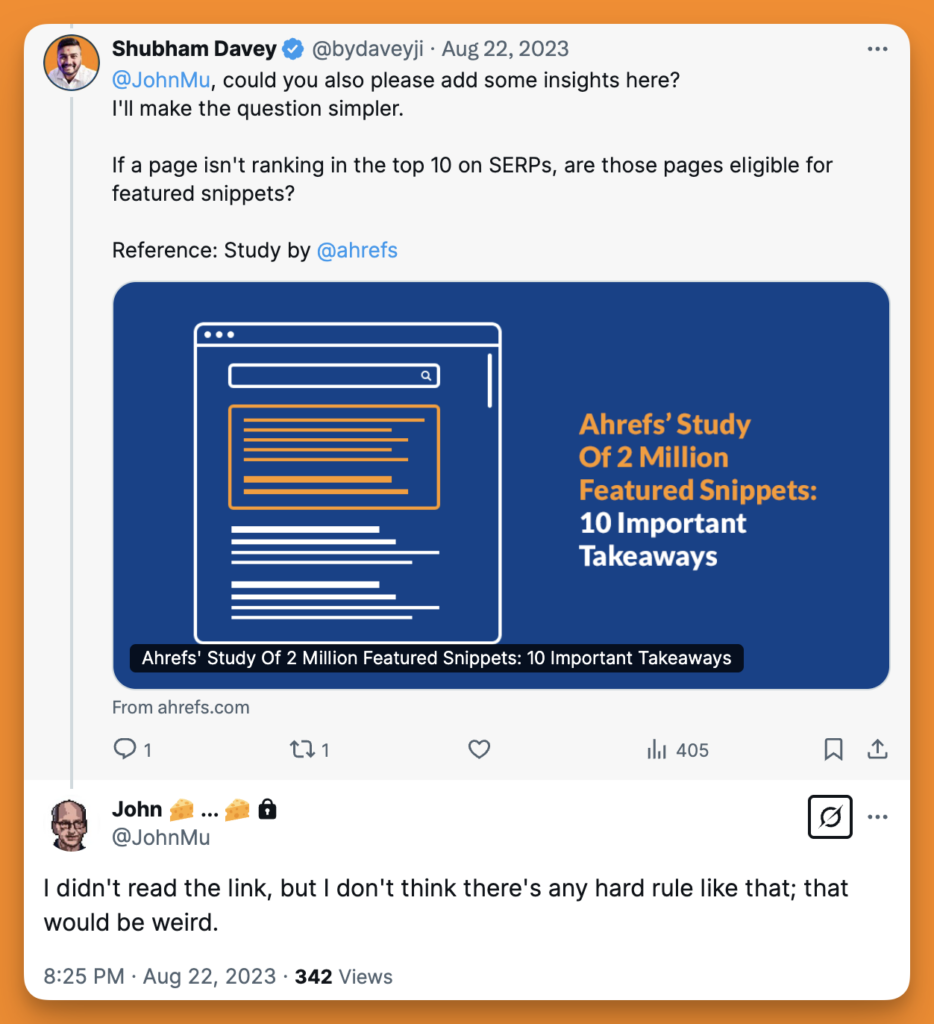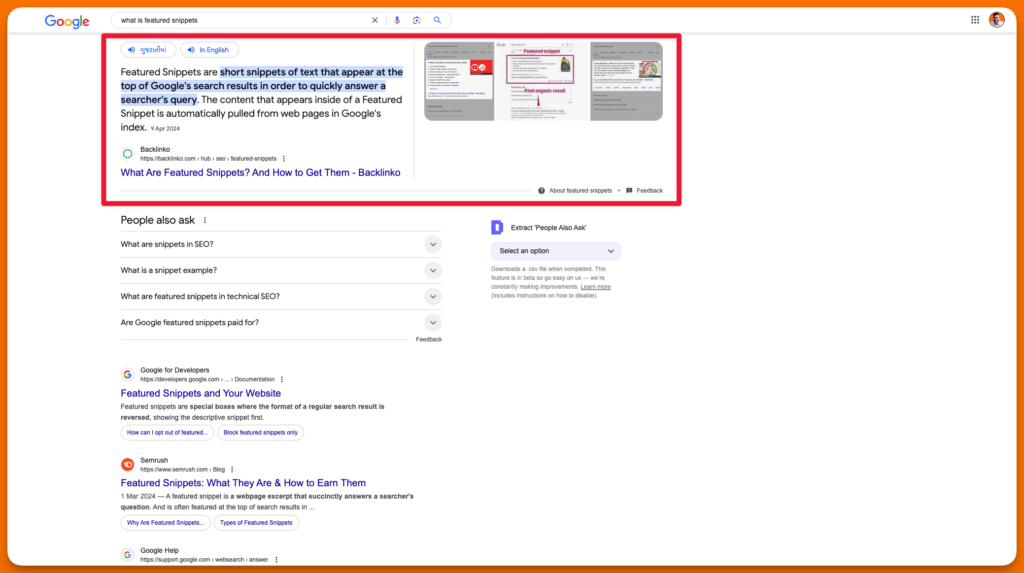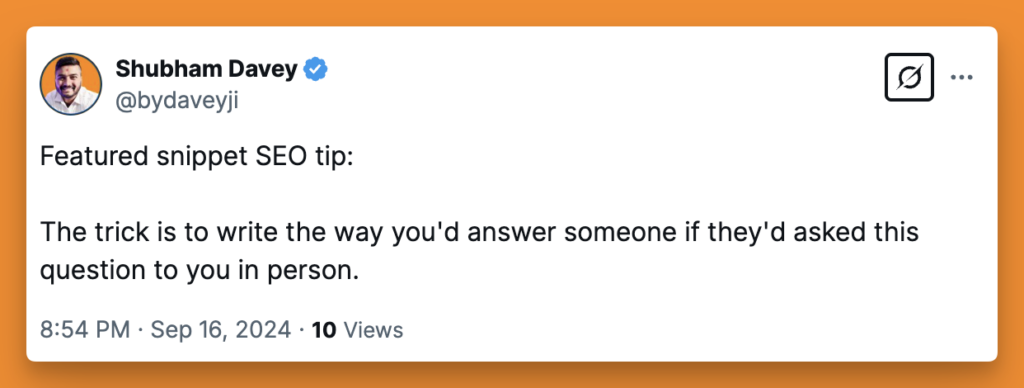Google’s John Mueller dropped a truth bomb on X (formerly Twitter), responding to my post about featured snippets. He revealed that a blog shouldn’t be in the top 10 search results to rank for position zero.
This revelation challenges traditional SEO wisdom and opens up exciting possibilities for content creators of all sizes.
Featured snippets, those eye-catching answer boxes at the top of search results, have become a game-changer in the SEO world. They offer a golden opportunity to boost visibility and click-through rates, even for newer or less established websites.
But here’s the kicker: optimizing for snippets isn’t just about rankings anymore. It’s about crafting clear, concise answers to user queries and structuring your content in an easily digestible way for both humans and search engines.
In this post, we’ll explore the details of featured snippet optimization and how this new information reshapes our approach to SEO.
Here’s what happened
I was researching for my newsletter when I stumbled upon this thread on X. I immediately asked Danny Sullivan what happens before a page ranks for the featured snippets. I didn’t get a reply, which I understand. It’s too old a tweet for him to come back and reply.
But then I tagged John Mueller to get an answer, which is what he said.

Featured Snippet Statistics
To give you some context about how crucial featured snippets are, here are some eyebrow-raising stats:
- 19% of searches have featured snippets
- 8.5 billion searchers happen on Google alone
- 35.1% of clicks go to featured snippets. Engine scout
- Featured snippets appear in 19% of search engine results pages (SERPs).
- Semrush found that 70% of featured snippets are paragraph snippets, while 19% are list snippets, and 6.3% are table snippets.
- Semrush also found that 29% of queries that trigger a featured snippet start with question-based words like “why,” “can,” and “do”.
- Embryo found out that featured snippets get approximately 35% of all clicks on search results.
- Backlinko found that 54% of featured snippets come from long-tail searches, with less than 50 searches per month.
- Only 0.4% of featured snippets link to homepages, indicating the importance of in-depth content pages.
- 66% of articles appearing in featured snippets have structured data.
- 40.7% of voice search results include featured snippet content.
- Featured snippets performed 42% better than regular search listings for clickthroughs.
- Moz found out that opting out of featured snippets led to a 12% loss in traffic.
Featured Snippet Success: Your Game Plan Starts Here

Ranking for featured snippets is like getting a VIP pass to the top of Google’s search results. Imagine you’re at a concert, and instead of being stuck in the crowd, you’re suddenly on stage with the band.
A featured snippet does that for your content – it puts you front and center, right where everyone can see you.
Let’s break it down in simple terms. When you search for something on Google, sometimes you’ll see a box at the top of the results that directly answers your question. That’s a featured snippet.
Google says, “Hey, we think this is the best answer to your question.” Your content can be in that box, which is pretty cool.
Now, why should you care about featured snippets? There are some pros and cons to consider.
Pros:
- You get more eyeballs on your content. You’re at the top of the page, above even the #1 organic result. As John said, you don’t need to be in the top 10 to rank for featured snippets.
- It can boost your credibility. If Google thinks you’ve got the best answer, that’s a pretty good endorsement.
- You might get more clicks. People love quick answers, and if you provide them, they’re more likely to visit your site.
Cons:
- Sometimes, people get their answer from the snippet and don’t click through to your site.
- It takes some effort to optimize for featured snippets. It’s not just about ranking high anymore.
- You’re not guaranteed to keep the featured snippet. Google can change its mind at any time.
Now, let’s talk about how you can start optimizing for featured snippets if you’ve never done it before.
#1 Understand the types of featured snippets.
There are different types of featured snippets, and knowing them can help you tailor your content. The main types are:
- Table snippets: These show data in a table format.
- Paragraph snippets: These are short text answers to questions.
- Video snippets: These show a relevant video with a specific timestamp.
- List snippets: These can be ordered (numbered) or unordered (bulleted) lists.
For example, searching “how to tie a tie” might see a list snippet with step-by-step instructions. If you search “what is photosynthesis,” you’ll probably see a paragraph snippet with a brief explanation.
#2 Find opportunities in your niche
Start by looking at the questions people are asking in your industry. Tools like AnswerThePublic or Google’s “People also ask” section can give you ideas. Look for questions that don’t have great featured snippets yet – that’s your opportunity to swoop in and provide a better answer.
#3 Structure your content for snippets
When writing, think about how to make your content snippet-friendly.
Here are some tips you can have handy when structuring your content:
- Use question-based headers (H2, H3) that match common search queries.
- Use bullet points or numbered lists for processes or lists of items.
- Create simple tables for comparisons or data presentation.
- Provide a clear, concise answer right after the question.
For instance, if you’re writing about “how to bake a cake,” you might have a header that says, “How long does it take to bake a cake?” followed by a clear, concise answer like “On average, it takes 30-35 minutes to bake a cake at 350°F (175°C), but this can vary depending on the type and size of the cake.”
- Focus on clarity and conciseness: Google loves clear, straightforward answers. Avoid fluff and get straight to the point. Do it if you can answer a question in 40-50 words. That’s often the sweet spot for paragraph snippets.
- Use schema markup: This is a bit more technical but worth learning about. Schema markup is code you can add to your website to help search engines understand your content better. It’s like giving Google a roadmap to your information.
- Create high-quality, comprehensive content: While snippets are short, they often come from longer, more detailed content. Don’t just write snippet-bait – create valuable, in-depth content that answers related questions and provides context.
- Target “long-tail” keywords: People search for longer, more specific phrases. They often have less competition and are great for featured snippets. Instead of targeting “cake recipes,” you might go for “how to make a moist chocolate cake without eggs.”
- Update your content regularly: Google loves fresh content. Periodically updating your posts can help you maintain or gain featured snippets. This doesn’t mean changing everything – even minor updates can help.
- Pay attention to user intent. Think about why someone is searching for a particular term. Are they looking to buy something, learn how to do something, or understand a concept? Tailor your content to match that intent.
- Be patient and persistent: Getting featured snippets isn’t an overnight process. It takes time, testing, and tweaking. Keep at it, and don’t get discouraged if you don’t see results immediately.
- Don’t forget about mobile: More and more searches are happening on phones, so make sure your content looks good and is easy to read on smaller screens. A featured snippet that’s hard to read on mobile isn’t going to do you much good.
Optimizing for featured snippets isn’t just about getting that top spot. It’s about creating explicit, helpful content that answers people’s questions. If you focus on that, you’re not only more likely to get featured snippets, but you’re also creating value for your audience.
Optimizing for featured snippets is an ongoing process. It’s about understanding your audience’s needs, providing clear and concise answers, and constantly refining your approach.
I found this video that will help you optimize your content for answer targets of featured snippets. I remember watching it soon after it was published. It was relevant back then, and it is relevant even today.
Three things you should do to optimize for position zero
#1 Ranking in the top 10 isn’t necessary
John Mueller’s comment about featured snippets not requiring top-10 rankings is a game-changer for SEO. It’s like finding a secret shortcut in a video game that lets you skip levels and reach the boss fight faster.
Imagine you’re a small bakery competing against big chains. In the past, you might’ve thought you needed to outrank those giants to get noticed. But now, even if your website is on page two or three of search results, you could still snag that coveted featured snippet spot.
For example, someone may search for “how to make sourdough bread.” Your detailed, well-structured guide could be chosen for the featured snippet, even if your overall site authority isn’t as high as a famous chef’s website. This means your sourdough recipe could be the first thing users see, potentially driving more traffic to your site.
This opens up possibilities for niche experts, local businesses, and new bloggers. It’s not just about who has the most backlinks or the highest domain authority anymore. It’s about who provides the most relevant, concise, and well-structured answer to the user’s query.
The key takeaway? Focus on creating high-quality, targeted content that directly answers specific questions in your field. You might be in the spotlight, even if you’re not usually in the top 10 results.
#2 Focus on answering questions clearly
Google’s mission is to serve up the most helpful answers to people’s questions; they’re pretty serious about it. When someone types in a query, Google wants to hand them the perfect nugget of information on a silver platter. That’s where you come in.
Think about how you’d explain something to a friend. You wouldn’t start with a long-winded intro or use fancy jargon. You’d get straight to the point with simple, straightforward language. That’s precisely what Google’s looking for in featured snippets.
Or if someone searches, “What’s photosynthesis?” A well-optimized answer target could be: “Photosynthesis is the process plants use to convert light energy into chemical energy. They absorb sunlight to turn carbon dioxide and water into glucose and oxygen.”

By structuring your content this way, you’re not just helping Google – you’re helping real people find the answers they need quickly. And when folks see that you’re giving them clear, useful info right off the bat, they’re more likely to trust you and dig deeper into your content.
It’s a win-win: you’re satisfying both Google’s algorithms and, more importantly, actual human readers.
#3 Optimize content structure
Proper HTML formatting gives your content a clear structure that both humans and search engines can easily understand. Think of it as organizing your house—when everything has its place, it’s easier to find what you need.
Let’s start with header tags. These are like signposts in your content. Use H1 for your main title, H2 for major sections, and H3 for subsections. For example, if you’re writing about baking, your structure might look like this:
H1: The Ultimate Guide to Baking Perfect Cookies
H2: Ingredients You’ll Need
H3: Types of Flour
H3: Choosing the Right Sugar
H2: Step-by-Step Baking Process
Lists are great for presenting steps or items in a clear, scannable format. Use ordered lists (<ol>) for processes and unordered lists (<ul>) for collections of items.
For instance:<ol> <li>Preheat the oven to 350°F</li> <li>Mix dry ingredients</li> <li>Add wet ingredients</li> </ol> Tables are perfect for comparing data or presenting information in a structured way.
They’re handy for price comparisons or nutritional information.
Using these HTML elements makes your content more readable for visitors and helps search engines understand the structure and context of your information.
This increases the chances of your content being selected for a featured snippet, as Google can quickly identify the most relevant parts of your page to display.
Time to Get That Featured Snippet(s): Your Next Steps
So, there you have it – the lowdown on featured snippets. Who would’ve thought you don’t need to be in the top 10 to snag that sweet spot? It’s like search engines like Google give a fair chance to everyone.
But don’t get too excited just yet. Optimizing for featured snippets isn’t a walk in the park. Crafting content that’s snippet-worthy requires some serious elbow grease. You’ve got to think like your audience, answer their questions clearly, and structure your content just right.
Remember, it’s not just about getting that snippet. It’s about creating content that genuinely helps people. Do that, and you’re already winning, snippet or no snippet.
So, roll up your sleeves and get to work. Who knows? Your next piece of content might just end up in that juicy position zero.

